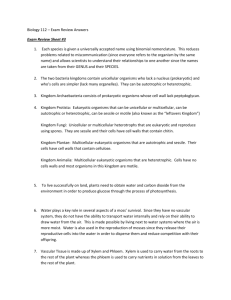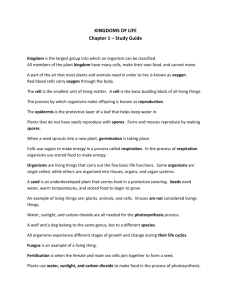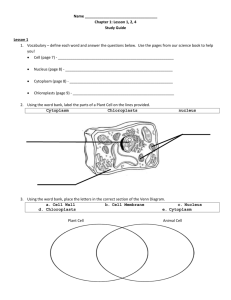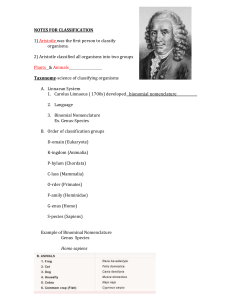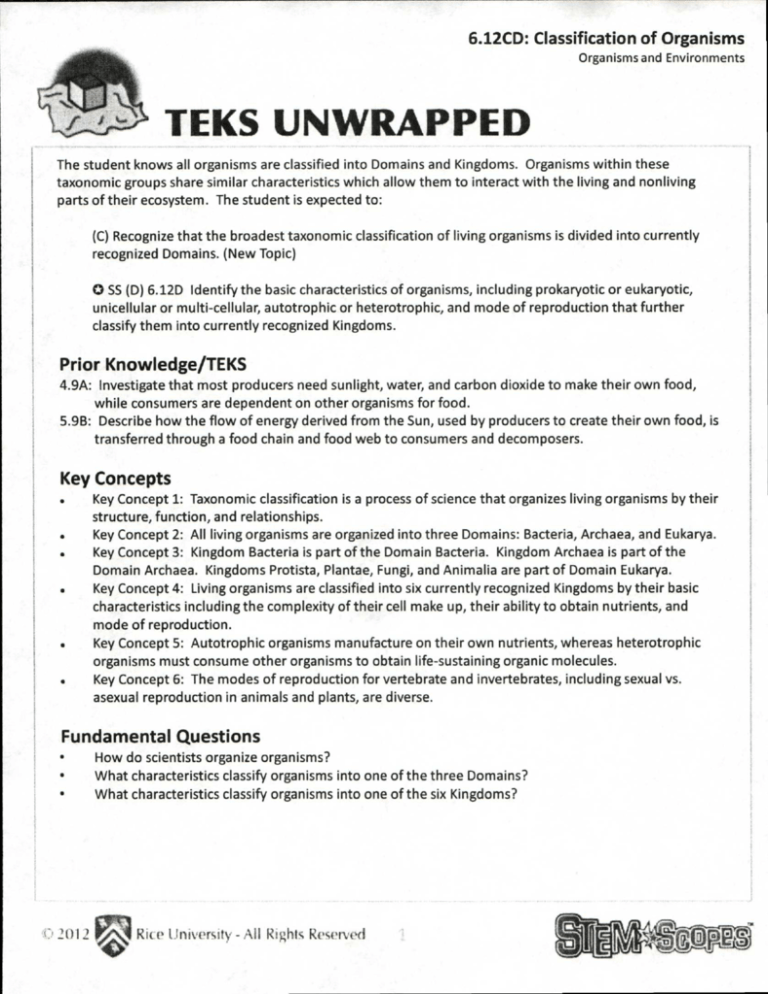
6.12CD: Classification of Organisms
Organisms and Environments
TEKS UNWRAPPED
The student knows all organisms are classified into Domains and Kingdoms. Organisms within these
taxonomic groups share similar characteristics which allow them to interact with the living and nonliving
parts of their ecosystem. The student is expected to:
(C) Recognize that the broadest taxonomic classification of living organisms is divided into currently
recognized Domains. (New Topic)
0 SS (D) 6.12D Identify the basic characteristics of organisms, including prokaryotic or eukaryotic,
unicellular or multi-cellular, autotrophic or heterotrophic, and mode of reproduction that further
classify them into currently recognized Kingdoms.
Prior Knowledge/TEKS
4.9A: Investigate that most producers need sunlight, water, and carbon dioxide to make their own food,
while consumers are dependent on other organisms for food.
5.9B: Describe how the flow of energy derived from the Sun, used by producers to create their own food, is
transferred through a food chain and food web to consumers and decomposers.
Key Concepts
•
•
•
•
Key Concept 1: Taxonomic classification is a process of science that organizes living organisms by their
structure, function, and relationships.
Key Concept 2: All living organisms are organized into three Domains: Bacteria, Archaea, and Eukarya.
Key Concept 3: Kingdom Bacteria is part of the Domain Bacteria. Kingdom Archaea is part of the
Domain Archaea. Kingdoms Protista, Plantae, Fungi, and Animalia are part of Domain Eukarya.
Key Concept 4: Living organisms are classified into six currently recognized Kingdoms by their basic
characteristics including the complexity of their cell make up, their ability to obtain nutrients, and
•
mode of reproduction.
Key Concept 5: Autotrophic organisms manufacture on their own nutrients, whereas heterotrophic
•
organisms must consume other organisms to obtain life-sustaining organic molecules.
Key Concept 6: The modes of reproduction for vertebrate and invertebrates, including sexual vs.
asexual reproduction in animals and plants, are diverse.
Fundamental Questions
•
How do scientists organize organisms?
•
What characteristics classify organisms into one of the three Domains?
•
What characteristics classify organisms into one of the six Kingdoms?
2012
Rice Linty
All Rights Reserved
6.12CD: Classification of Organisms
Organisms and Environments
TEKS UNWRAPPED
Implications for Instruction
Make sure that students understand that eukaryote cells have many internal structures which each have their
own membranes surrounding them. One of these is the nucleus. These membranes are different than the
cellular membrane which surrounds the cell and separates it from the environment. The only membrane that a
prokaryote cell has is the exterior cellular membrane.
• Students might think that algae are plants. In fact, most are protists since all plants are mulitcellular, while
most algae are unicellular - even though some of them grow in colonies large enough to be visible.
• Students might think archae are very primitive forms of bacteria; in fact, life scientists thought the same thing
when they were first discovered, originally naming them Archaebacteria, which means "ancient bacteria" and
classifying them both in the same Kingdom. More sophisticated methods of analysis revealed that archae were
not the ancestors of bacteria.
•
Dissecting TEKS Nouns
domain
prokaryotic
eukaryotic
unicellular
multicellular
autotrophic
heterotrophic
reproduction
Kingdom
Dissecting TEKS Verbs
Recognize
1. To acknowledge formally.
2. To acknowledge or take notice of is some definite way.
Bloom's Taxonomy: Knowledge
Bloom's Revised: Remember
Knowledge
(Remembering)
Prompts at the
REMEMBER
Comprehension
(Understanding)
Application
(Applying)
Analysis
(Analyzing)
Synthesis
(Evaluating)
Evaluation
(Creating)
I
I
I
i
I
level include:
Recognize, Identify, Recall, Name, Match, Retrieve, List, Memorize
How will your students
REMEMBER
the concepts in 6.12CD TEKS?
Examples of prompts for this level of content knowledge include:
•
What is the broadest taxonomic level of classification?
2012 " Rice University - All Rights Reserved
6.12CD: Classification of Organisms
Organisms and Environments
TEKS UNWRAPPED
Dissecting TEKS Verbs
Identify
•
•
To cause to be or become identical.
To establish the identity of
Bloom's Taxonomy: Knowledge
Bloom's Revised: Remember
Knowledge
(Remembering)
Prompts at the
REMEMBER
Comprehension
(Understanding)
Application
(Applying)
Analysis
(Analyzing)
Synthesis
(Evaluating)
Evaluation
(Creating)
I
I
I
i
I
level include:
Recognize, Identify, Recall, Name, Match, Retrieve, List, Memorize
How will your students
REMEMBER
the concepts in 6.12CD TEKS?
Examples of prompts for this level of content knowledge include:
•
.
Which characteristics identify bacteria?
Which Kingdom contains dogs, cats, and humans?
Definition Source: Merriam Webster Dictionary
)
01 2
Rice Uni -
city - All Rights Reserved
6.12CD: Classification of Organisms
Organisms and Environments
TEKS UNWRAPPED
STAARTm: 2013 Released 8th Grade Test Questions
For 6.12CD: Question #47
47 The characteristics of a particular organism are listed below.
Characteristics of an Organism
• Is multicellular
• Is autotrophic
• Has cell walls
• Has cell nuclei
• Can reproduce sexually or asexually
In which kingdom should this organism be classified?
A
Fungi
B
Eubacteria
VC Plantae
D
012
Animalia
Rice University - All Rights Reserved
8th Grade Math 6.12D
Date
Name
Class/Grade
1
Expectation: 6.12(D)
Tigers, sponges, and whales are all members of the animal kingdom. These
organisms are very different, but are similar in some ways. Which of the following is a
characteristic used to classify these organisms as animals?
A
They eat other living organisms.
B
They feed on decomposing organic matter.
C They have fur.
D They have cell walls.
Directions: The diagram below shows some characteristics of four kingdoms. Use the
diagram and your knowledge of science to answer any questions that follow.
Eukaryotes
1
Kingdom 3
Kingdom 4
Unicellular
Multicellular
Unicellular
or
Multicellular
v
Heterotrophic
Autotrophic
Kingdom 1
1
Multicellular
Multicellular
Or
Heterotrophic
Autotrophic
Or
Heterotrophic
©1999-2012 Progress Testing
Page 1
8th Grade Math 6.12D
2
Expectation: 6.12(D)
Eukaryotes are classified into four kingdoms according to certain characteristics.
Which of these is the animal kingdom?
3
F
Kingdom 1
G
Kingdom 2
H
Kingdom 3
3
Kingdom 4
Expectation: 6.12(D)
Eukaryotes are classified into four kingdoms according to certain characteristics.
Which of these is the fungi kingdom?
4
A
Kingdom 1
B
Kingdom 2
C
Kingdom 3
D
Kingdom 4
Expectation: 6.12(D)
Oomycetes, also known as water molds, compose a group of organisms that belong
to the kingdom Protista. What is a characteristic of oomycetes that allow them to be
placed in this kingdom?
F
Oomycetes cannot sexually reproduce.
G
Oomycetes are found in every habitat on Earth.
H
Oomycetes have chloroplasts that are green in color.
3
Oomycetes are either unicellular or multicellular without any specialized tissues.
©1999-2012 Progress Testing
Page 2
8th Grade Math 6.12D
5
Expectation: 6.12(D)
Mushrooms and yeasts reproduce by spores and are composed of cells enclosed by
cell walls. These organisms fall into which kingdom?
6
A
Plant
B
Protist
C
Archaea
D
Fungus
Expectation: 6.12(D)
Agaricus bisporus, also known as the Portobello mushroom, belongs to the kingdom
Fungi. One of the characteristics that defines Agaricus bisporus as a fungus is that it
has
7
F
nuclei in its cells.
G
pigment in its skin.
H
the ability to ingest other organisms.
3
the ability to photosynthesize.
Expectation: 6.12(D)
Haloquadratum walsbyi is a species of archaeon that belongs to the kingdom Archaea.
Since Haloquadratum walsbyi is in this kingdom, which of the following must be true?
A Haloquadratum walsbyi is a unicellular organism.
B
Haloquadratum walsbyi produces food through photosynthesis.
C
Haloquadratum walsbyi produces seeds.
D
Haloquadratum walsbyi undergoes a metamorphosis when it matures from larva
into an adult.
©1999-2012 Progress Testing
Page 3
8th Grade Math 6.12D
8
Expectation: 6.12(D)
Epulopiscium fishelsoni is a species of bacterium that belongs to the kingdom
Bacteria. What is a characteristic of Epulopiscium fishelsoni that allows it to be placed
in this kingdom?
F
Epulopiscium fishelsoni lacks a cell nucleus.
G Epulopiscium fishelsoni cannot move.
H Epulopiscium fishelsoni obtains energy from sunlight using photosynthesis.
3
9
Epulopiscium fishelsoni is a multicellular organism.
Expectation: 6.12(D)
Termites are classified in the kingdom Animalia What is a characteristic of termites
that allows them to be placed in this kingdom?
A Termites are unicellular organisms.
B Termites get energy from sunlight.
C
Termites are parasites that cause disease.
D Termites get energy from other organisms.
10 Expectation: 6.12(D)
Gyromitra esculenta, also known as the false morel, belongs to the kingdom Fungi.
What is a characteristic of Gyromitra esculenta that allows it to be placed in this
kingdom?
F
Gyromitra esculenta converts nitrogen to ammonia.
G Gyromitra esculenta lives in marine environments.
H
Gyromitra esculenta can move using a tail-like structure.
3
Gyromitra esculenta produces and uses chlorophyll.
©1999-2012 Progress Testing
Page 4
8th Grade Math 6.12D
Instructions to read aloud to your students.
When you decide what the answer to a question is, mark your answer on your answer sheet. To do so,
find the row of circles with the same number as the question. Then darken in the circle with the same
letter as the answer you chose. If you don't know the answer to a question, skip it. You may return to it
later if you have time. If you finish the test early, you should go back and check over your work. Do NOT
fold your answer sheet or make any stray marks.
When marking your answer sheet:
1. Make a heavy mark. The mark should be large enough to fill the circle, but it should not go outside too
much. Do not waste time making very neat marks. It is more important to make very dark marks. Be sure
to use a #2 pencil.
2. Be sure that your mark for every question is placed in the row with the same number as that question.
3. Make only ONE mark in a row. If you change your mind about an answer, erase your first mark as
completely as you can.
()Ogg() OCDCDCD• 0•Ogg 0•©8®
0•480 Cl®CDCD• 00©8©
0 ®0•© ()Ogg() 0 ®10(D•
8th Grade Math 6.12D
Readiness or
Supporting
Content Student
Expectation
Process Student
Expectation
Correct
Answer
Item
Number
Reporting
Category
1
4
Supporting
6.12(D)
A
2
4
Supporting
6.12(D)
F
3
4
Supporting
6.12(D)
C
4
4
Supporting
6.12(D)
3
5
4
Supporting
6.12(D)
D
6
4
Supporting
6.12(D)
F
7
4
Supporting
6.12(D)
A
8
4
Supporting
6.12(D)
F
9
4
Supporting
6.12(D)
D
10
4
Supporting
6.12(D)
F
©1999-2012 Progress Testing
Date
Name
6.12.D
STANDARD PRACTICE
1 How do organisms in the kingdom Fungi differ from those in the kingdom Animalia?
A Organisms in the kingdom Fungi are unicellular.
B Organisms in the kingdom Fungi cannot move.
C Organisms in the kingdom Fungi reproduce sexually.
D Organisms in the kingdom Fungi undergo photosynthesis.
2 You discover a new organism in an extreme environment. It is a unicellular
prokaryote that does not photosynthesize. In which domain would you classify the
organism?
A Archaea
C Plantae
B Fungi
D Protista
The Salt-Marsh Ecosystem
3 Imagine that you are an ecologist cataloging the interactions
in a salt-marsh community. Look at the illustration above of
some of the organisms that live in a salt marsh. Within this
ecosystem, the organisms are the seaside sparrow, the
cordgrass, the marsh crab, and the shrimp. How many living
things shown in the ecosystem belong to the kingdom
Animalia?
0000
0000
0000
CD CD C) CD
0000
CD C) CD CD
CD CD CD CD
0000
C) CD CD CD
0000
CD CD
00
CD C)
CD CD
0®
CD CD
CD CD
CD CD
CD CD
CD CD
Houghton Mifflin Harcourt Publishing Company
113
Texas Assessment Review and Practice
6.12CD: Classification of Organisms
Organisms and Environments
14 OC)C)()
15 •0© CD
16 0
PRE-ASSESSMENT
19 00 00
1
Pictured below is chart containing characteristics of different
Kingdom classifications.
Kingdom
Cells
Energy
Reproduction
Fungi
Many
Heterotrophic
Sexual &
asexual
Plants
?
?
?
What options correctly fill in the rest of the chart?
4
Per:
Date:
Name:
17 CJ l's431)
18 0(1)0 0
A
Many, heterotrophic, asexual
B
One, autotrophic, sexual & asexual
C
One or many, Autotrophic, sexual & asexual
D
One or many, heterotrophic, sexual
02013 Rice University - All Rights Reserved
PRE-ASSESSMENT
6.12CD: Classification of Organisms
Organisms and Environments
The broadest taxonomic group for classifying living
organisms is the —
2
3
A
Domain
B
Kingdom
C
Family
D
Genus
Of the characteristic comparisons in the list below, which
option is one of those used for classifying an organism into a
taxonomic Kingdom?
A
Has nucleus / does not have nucleus
B
Internal skeleton / exoskeleton
C
Multicellular / unicellular
D
Broad leaves / narrow leaves
© 2013 Rice University - All Rights Reserved
PRE-ASSESSMENT
4
5
6.12CD: Classification of Organisms
Organisms and Environments
Which characteristic is always true for each and every member of
the Animal Kingdom?
A
It is heterotrophic
B
Is unicellular
C
Does not have a nucleus
D
Reproduces asexually
Which of the following is true about all members of the kingdom
fungi? All fungi A
are made of cells without a nucleus
B
must consume other organisms for energy
C
reproduce asexually by budding
D
are microscopic unicellular organisms
© 2013 Rice University - All Rights Reserved
Command term used: Compare
Give an account of the similarities and differences between two (or more) items or situations, referring to both (all) of them throughout.
Prokaryotes Vs. Eukaryotes
r)
(--Prokaryotes
Key
Are all Bacteria
Have organelles
Have DNA
Have cell walls
Have Ribosomes
No organelles
Can have flagella (tails)
Simple Cells
Have cytoplasm
Reproduce by Binary Fission
Have a membrane bound nucleus
Plant cells have cell walls
More complex cells
Reproduce by Mitosis/Meiosis
Reproduce
Are alive
Both
Eukaryotes
Prokaryotes
Classification of Living Things: TEKS 6.12D
/This powerpoint and all the attachments can be found at:
To the teacher:
•
http://txstar.cpo.com/samplesiteacher/pdf/6 12D teacher.pdf
This CPO Science PowerPoint presentation is designed to guide you
through the process of presenting the lesson to your students. The
presentation uses a 5-E teaching model: Engage, Explore, Explain,
Elaborate, and Evaluate.
•
The PowerPoint Slide notes indicate where you may want to bring in
various lesson elements such as quizzes, readings, investigations,
animations, and practice materials. Additional science background
information is provided in the slide notes where appropriate. You can
view these notes by selecting "View," then "Normal." You will see the
notes pane at the bottom of the PowerPoint workspace. Additionally,
the slide notes are available as a separate document, accessible from
the lesson home page.
•
The slides that follow are intended for classroom use.
2011 CPO Science. All rights reserved
cpo
science
Classification of Living Things: TEKS 6.12D
Three questions
• A living thing can belong to one of
three groups: domain Archaea,
domain Bacteria, or domain Eukarya.
•
Domain Eukarya includes the
kingdoms Protista, Fungi, Plantae, and
Animalia.
• To pick the right group, scientists often
ask the three questions at right.
1. Do its cells have a nucleus?
2. Single-celled or multicellular?
3. Producer or consumer ?
• Answer the three questions for the
following organisms:
E. coli
Human being Starfish
Water flea Puffball
Daffodil
2011 CPO Science. All rights reserved.
cpo
science
Classification of Living Things: TEKS 6.12D
Time to investigate!
• Complete the lesson investigation:
— Classifying Living Things
A Dichotomous Key
to the Eukaryote Kingdoms
la. No nucleus
lb. Nucleus
Go to 2
Go to 3
2.
Prokaryote domains
3a.
Single-celled
Kingdom Protista
3b.
Multicellular
Go to 4
au■..........elemonommo
4a. Producers
Kingdom Plantae
4b. Consumers
Go to 5
5a. Break down and absorb
rotting organisms
Kingdom Fungi
5b. Eat other organisms
2011 CPO Science. All rights reserved.
cpo
science
Classification of Living Things: TEKS 6.12
Classifying by type of cells
• All living cells can be classified into two groups:
prokaryotic and eukaryotic.
• prokaryotic cell a cell that does not have a nucleus
or membrane-covered organelles. Bacteria are
prokaryotic.
-
• eukaryotic cell a cell that has a nucleus and
membrane-covered organelles. Animals, plants, fungi,
and protozoans are eukaryotic.
-
2011 CPO Science. All rights reserved.
cpo
science
Classification of Living Things: TEKS 6.12D
Type of cells
Prokaryotic cell
Cytoplasm
Organelles not
covered by
membrane
DNA
ell
membrane
,
c)
2011 CPO Science. All rights reserved.
Prokaryotic
cells
Eukaryotic
cells
Bacteria
All other cells
No nucleus
Nucleus
Organelles not
membranecovered
Membranecovered
organelles
DNA is
bunched up in
the center of the
cell
DNA is found in
the nucleus
Eukaryotic cell
Membrane
bound
nucleus
Various
membrane bound
organelles
Cell
membrane
Cytoplasm
cpo
science
Classification of Living Things: TEKS 6.12D
SCIENCE
TEKS
ASSESSMENT
READY
Classifying by how a living thing
gets energy
Plants
... are multicellular.
• A producer can make its own
food. Another name for a
producer is autotroph.
• A consumer eats other living
things for food and energy.
Another name for a
consumer is heterotroph.
((
2011 GPO Science. All rights reserved
.
... cells have a nucleus.
.
... make their own
food (photosynthesis).
Animals ...
... are multicellular.
... cells have a nucleus.
Nucleus
... eat other
organisms.
cpo
science
Classification of Living Things: TEKS 6.12D
Classifying by mode of reproduction
• There are two types of reproduction: asexual and sexual.
II
• Asexual reproduction is reproduction that
requires only one parent. Most single-celled
organisms like bacteria and protozoans
reproduce this way. Offspring are identical to
the parent.
• Sexual reproduction is a type
of reproduction that involves
special types of cells called
sex cells. Off-spring have a
new combination of genetic
material from the sex cells
of the parents.
2011 CPO Science. All rights reserved
.
Parents - Diploid
Cell division
Parent cell
Daughter cells
Sex cells - Haploid
Zygote - Diploid
Sperm
0
6 Homologous
pairs =
12 Chromosomes
Offspring - Diploid
Fedi ization 0
Egg
7Ar
6 Homologous
pairs =
12 Chromosomes
--■
ar
Cp0 science
Classification of Living Things: TEKS 6.12D
SCIENC E
TEKS
ASSESSMENT
R EADY
Time for Practice!
• Complete the lesson practice activity
below:
For each organism below, name the
kingdom, type of cells, mode of obtaining
energy, and mode of reproduction.
irs 2011 CPO Science. All rights reserved
cpo
science
Classification of Living Things: TEKS 6.12D
Show what you know!
• Try the lesson's interactive quiz, or complete a quiz
that your teacher can print out for you.
• Hint:
— You might want to review your lesson reading piece one
more time before trying the quiz.
cpo
science
Classification of Living Things: TEKS 6.12D
To the teacher:
•
This CPO Science PowerPoint presentation is designed to guide you
through the process of presenting the lesson to your students. The
presentation uses a 5-E teaching model: Engage, Explore, Explain,
Elaborate, and Evaluate.
•
The PowerPoint Slide notes indicate where you may want to bring in
various lesson elements such as quizzes, readings, investigations,
animations, and practice materials. Additional science background
information is provided in the slide notes where appropriate. You
can view these notes by selecting "View," then "Normal." You will see
the notes pane at the bottom of the PowerPoint workspace.
Additionally, the slide notes are available as a separate document,
accessible from the lesson home page.
•
The slides that follow are intended for classroom use.
About the slide notes:
The slide notes for this presentation are available in a separate document that you
can print and look at while you use the slides. You can access the slide notes
document from your teacher lesson home page.
Enjoy the lesson!
1
Classification of Living Things: TEKS 6.12D
Three questions
•
A living thing can belong to one of
3 groups: domain Archaea, domain
Bacteria, or domain Eukarya .
•
Domain Eukarya includes the
kingdoms Protista, Fungi, Plantae, and
Animalia
• To pick the right group, scientists often
ask the 3 questions at right.
•
1. Do its cells have a nucleus?
2. Single-celled or multicellular?
3. Producer or consumer ?
Answer the 3 questions for the
following organisms:
Human being Starfish
E. coli
Daffodil
Water flea Puffball
ENGAGE: Answers to the questions: E. coli (no nucleus, single-celled, consumer since
it needs nutrients), water flea (nucleus, multicellular, consumer), human being
(nucleus, multicellular, consumer), puffball (nucleus, multicellular, consumer--a
decomposer), starfish (nucleus, multicellular, consumer), daffodil (nucleus,
multicellular, producer).
2
Classification of Living Things: TEKS 6.12D
Time to investigate!
• Complete the lesson investigation:
A Dichotomous Key
to the Eukaryote Kingdoms
— Classifying Living Things
la. No rtudeus
Go to 2
2. Prokaryote domains
3a.
&no:a-celled
Kingdom Protista
3b.
klulticeauar ..._—._.... Go to 4
4a.
Producers
Kingdom Plant.
ab. Consumers
5a.
(
Go to 5
Break down and absorb
rotting organisms
,,,,,ir-rn
Fungi
5b. Eat other organisms
Kingdom AnimaN,
EXPLORE:
Lead the lesson investigation: Classifying Living Things. The graphic on this slide
provides a dichotomous key that students may use to classify the organisms they find
by kingdom.
3
Classification of Living Things: TEKS 6.12D
Classifying by type of cells
• All living cells can be classified into two groups:
prokaryotic and eukaryotic.
• prokaryotic cell - a cell that does not have a nucleus
or membrane-covered organelles. Bacteria are
prokaryotic.
• eukaryotic cell - a cell that has a nucleus and
membrane-covered organelles. Animals, plants, fungi,
and protozoans are eukaryotic.
EXPLAIN: More about prokaryotic cells: The word prokaryotic means "before nucleus"
in Greek. Scientists believe that all life on Earth came from these cells. The oldest
fossils of bacteria are estimated to be 3.5 billion years old. The DNA in a prokaryotic
cell is bunched up in the center of the cell. The organelles are not covered with a
membrane. All prokaryotic cells are much smaller than eukaryotic cells. More about
eukaryotic cells: The word eukaryotic means "true nucleus" in Greek. The oldest
fossils of eukaryotic cells are about 2 billion years old. There is more DNA in these
types of cells and it is found in the nucleus. These cells have membrane-covered
organelles. They tend to be about ten times larger than prokaryotic cells.
4
Classification of Living Things: TEKS 6.12D
Type of cells
Prokaryotic
cells
Eukaryotic
cells
Bacteria
All other cells
No nucleus
Nucleus
Organelles not
membranecovered
Membrane.
covered
DNA is
bunched up in
the center of the
cell
Eukaryotic cell
organelles
DNA is found in
the nucleus
EXPLAIN: The graphics on this slide support the previous slide. Note: Help students
understand that the cells featured are very small. As mentioned on the previous
slide's notes, prokaryotic cells are much smaller than eukaryotic cells. For example, a
human cheek cell (a eukaryotic cell) is visible with the aid of a microscope using a 40x
objective or higher.
Classification of Living Things: TEKS 6.12D
Classifying by how a living thing gets
energy
Plants
are multscoltular.
`
cans
mu,have a
nude..
• A producer can make its own
food. Another name for a
producer is autotroph.
• A consumer eats other living
things for food and energy.
.. make their own
food iphotosynthesis).
Animals ..
re muttrcellular
Another name for a
consumer is heterotroph.
EXPLAIN: Some bacteria, some protists, algae, and plants are able to produce their
own food. Consumers may be herbivores (plant-eating), carnivores (animal-eating), or
omnivores (both plant- and animal-eating). Decomposers like bacteria and fungi are
also considered to be consumers.
6
Classification of Living Things: TEKS 6.12D
Classifying by mode of reproduction
• There are two types of reproduction: asexual and sexual.
•
Asexual reproduction is reproduction that
requires only one parent. Most single-celled
organisms like bacteria and protozoans
reproduce this way. Offspring are identical to
the parent.
•
Sexual reproduction is a type
of reproduction that involves
special types of cells called
sex cells. Off-spring have a
new combination of genetic
material from the sex cells
of the parents.
Parents - Diploid Sex cells - Hapkad Zygote - Oiplad
Sperm
OtP
Offs. , r D of, r
0
6 Homologous
Fertazaton
12
t
pairs =
12 Chromosomes
Egg
41err:
6 Homologous
pars -_,
, 2 Chromosomes
EXPLAIN: More about asexual reproduction: Asexual reproduction is reproduction
that requires only one parent. Most single-celled organisms like bacteria and
protozoans reproduce this way. Cell division is a type of asexual reproduction. Body
cells reproduce this way. In asexual reproduction, the DNA and internal structures are
copied. Then the parent cell divides, forming two cells that are exact copies of the
original. More about sexual reproduction: Sex cells (also known as gametes) contain
half the number of chromosomes as body cells (all of the other cells in a multicellular
organism). Human body cells are diploid and have 46 chromosomes. Human sex cells
are haploid and have 23 chromosomes. The male sex cells are called sperm. The
female sex cells are called eggs.
7
Classification of Living Things: TEKS 6.12D
Time for Practice!
• Complete the lesson practice activity
below:
For each organism below, name the
kingdom, type of cells, mode of obtaining
energy, and mode of reproduction.
ELABORATE: Students may need to research answers to these questions. Answers are:
A. Animalia, eukaryotic and multicellular, a consumer, sexual reproduction; B.
Eubacteria or Archaebacteria, prokaryotic and single-celled, could be a producer or
consumer, asexual reproduction; C. Protista (this is a Euglena), eukaryotic and singlecelled, can act as a producer and a consumer, asexual reproduction; D. Plantae,
eukaryotic and multicellular, producer, sexual reproduction.
8
Classification of Living Things: TEKS 6.12D
Show what you know!
• Try the lesson's interactive quiz, or complete a quiz
that your teacher can print out for you.
•
Hint:
— You might want to review your
lesson reading piece one more time
before trying the quiz.
EVALUATE:
Print out the 10-question quiz for students to complete, or have students work
individually at computers to complete the interactive quiz they can access from the
multimedia lesson home page.
9
Practice Test
Classification of Living Things
Dates
Name:
1. Which of the following is NOT a kingdom in the domain
Eukarya?
a. Plantae
b. Bacteria
c. Fungi
d. Protista
6. Which of the following kingdoms has only heterotrophic
organisms?
a. Protista
b. Plantae
c. Animalia
d. none of the kingdoms above have heterotrophic
organisms
2. What is true about the domains Archaea and Bacteria?
a.
b.
c.
d.
all members are prokaryotes
all members are eukaryotes
members can be prokaryotes or eukaryotes
all members have a true nucleus
3. Which group has ONLY multicellular members?
a. domain Bacteria
b. kingdom Fungi
c. kingdom Animalia
d. kingdom Protista
7. Which of the following groups has members that only
reproduce asexually?
a.
b.
c.
d.
kingdom Fungi
kingdom Plantae
domain Bacteria
kingdom Animalia
(QUESTIONS 8 - 10 ARE ON THE NEXT PAGE)
4. Euglenas are one-celled, eukaryotic organisms that live in
ponds. They are green and can make their own food, but
sometimes they find food instead of making their own.
Euglenas are:
a. multicellular.
b. heterotrophic only.
c. autotrophic only.
d. both autotrophic and heterotrophic.
5. What is the major difference between prokaryotic and
eukaryotic cells?
a. Prokaryotic cells have no nucleus.
b. Prokaryotic cells do not reproduce.
c. Prokaryotic cells are much larger.
d. Prokaryotic cells contain no DNA.
St1 [1.4 ct
Ttics
AS S E ssmata r
ItEADy
TEKS 6.12D: Classification of Living Things p.1
© 2011 CPO Science. All rights reserved.
Practice Test
USE THE ILLUSTRATION BELOW FOR THE NEXT
Classification of Living Things
3
QUESTIONS:
8. Which of the organisms in the illustration above are unicellular?
a.
b.
c.
d.
A and B
B and C
C only
C and D
9. Which of the organisms in the illustration above are definitely autotrophic?
a. A and B
b. B and C
c. A and D
d. D only
10. Which of the organisms in the illustration belongs to the kingdom Animalia?
a.
b.
c.
d.
A
B
C
D
TLKS
:ScItsysmoir
TEKS 6.12D: Classification of Living Things p. 2
© 2011 CPO Science. All rights reserved.






